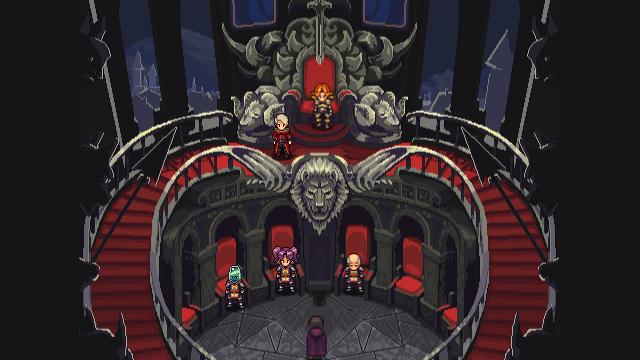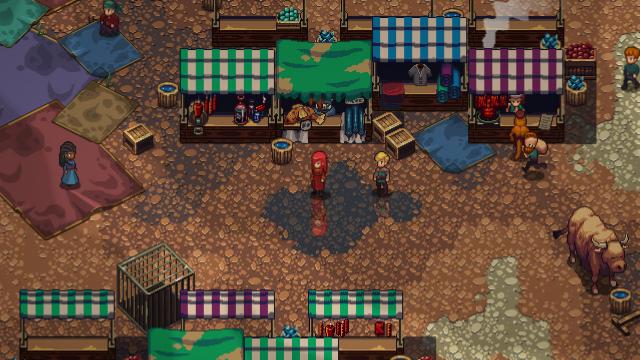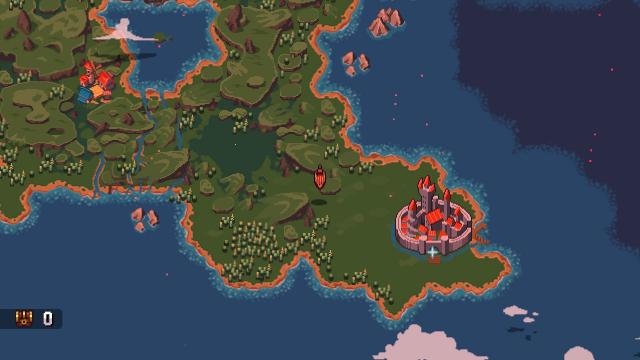Existing User Log In
New User Registration
Register for a free account to gain full access to the VGChartz Network and join our thriving community.





America - Front


America - Back

It's amazing what one person can do. In the video game industry we're used to seeing teams of hundreds working on high-profile video games for years, and then not always delivering on time or on promises made. Yet with a clear vision and enough time and funding, a single person can, in some cases, create a game more interesting than those produced by legions of developers, programmers, modelers, artists, and play testers. That is absolutely the case with Chained Echoes, a throwback turn-based role-playing game that is primarily composed of the blood, sweat, and tears of one man: Matthias Linda.
Like most great RPGs, Chained Echoes has an epic backstory. The game takes place on the continent of Valandis, separated by oceans from neighboring kingdoms and city states. Once home to the magical city of Nhysa, the world's center of magical teaching, Valandis in more recent times has been wracked by warfare. The three independent kingdoms on the continent, Taryn, Gravos, and Escanya, have fought a bloody war for decades.

This is the historical context for the brilliant narrative in Chained Echoes, which delivers extraordinary world-building, character development, and story-telling. Linda did an exceptional job laying out the political, cultural, religious, martial, racial, and economic realities of Valandis, resulting in a believable world where character decisions are defensible, even when unsavory. This is reinforced by the precise, crisp characterization of the world's many heroes, villains, and hangers-on. Each character has a distinct personality with a clear set of priorities and motivations. Moreover, each character grows in the game, in small or large ways. Every important character has a pay-off to their set-up, although you might have to wait a while to see them all.
That brings us to the one flaw in an otherwise terrific story. It can sometimes take a very long time to unravel a mystery, explain a certain alliance, or deliver on an earlier tease. There are moments, particularly in the middle of the game, where you might find yourself confused and overwhelmed about all the shifting allegiances, competing factions, and undefined relationships. Eventually, Linda provides answers that make perfect sense, and which mesh neatly with the logic of the world, but until then you're left asking "why?"
You won't be left asking for anything when it comes to the game's mechanics and tactical gameplay, however. Developed in the style of early-90s Final Fantasy titles, Chained Echoes is everything you'd expect from a Japanese RPG of the era, with an added twist. You'll form a party, travel across Valandis on a heroic quest, explore dungeons along the way, and fight in plenty of turn-based battles against monsters, soldiers, bandits, and fearsome bosses. In general, the game's early mechanics are straightforward and conventional. On each character's turn they can attack, use items, defend, or deploy skills, which cost TP. Then, with the introduction of the Overdrive Bar, things get interesting.

The Overdrive Bar is the heart of the battle system in Chained Echoes. The bar, which appears in the upper-left portion of the screen, is divided into three areas: yellow, green, and red, moving from left to right. Each battle begins in the leftmost yellow bar, and moves to the right as the party takes individual actions. Once in the middle green area, aka Overdrive, the party is in perfect synergy; characters take less damage, deal more damage, and only need to spend half as much TP on skills. If the party keeps going at this rate, though, they'll end up in the rightmost red area and overheat. This allows enemy attacks to do massive damage. Once on the cusp or in the middle of the red area, players will need to take one of several actions to return to Overdrive, or risk being overwhelmed.
The easiest, quickest way is to use the right kind of skill in the moment. In a box to the left of the Overdrive Bar is an icon that designates a certain type of skill: magic, healing, attack, buff, debuff, etc. If you use that skill when the icon is still active, you can push the dial significantly to the left and escape the dangerous overheat zone. As a result, players must watch the Overdrive bar, think tactically, and be willing to improvise. They should also strategize ahead of time to ensure the party has a healthy range of skill types equipped. Overall, the Overdrive system is an excellent addition to the battle framework in the game. It adds a risk/reward element to the proceedings, and forces you to switch things up and act outside of your comfort zone.

The Overdrive system, and the tactical decision-making in Chained Echoes in general, is further textured by character switching. Each of the four active characters in the party can be linked to a reserve character, which allows eight total combatants in battle. Two characters share a single battle slot and can be switched out freely within battle. Importantly, the swap itself doesn't function as a turn, meaning the swapped-in character can act immediately. This "tag-team" feature opens up many new avenues for tactical and strategic thinking. First, swapping lowers the Overdrive meter; second, you can swap out characters low on HP and TP, and replace them with healthier, stronger allies; third, you can essentially double the number of skills available to the party during a fight. Combined with Overdrive, character switching makes Chained Echoes a deeper strategic exercise than your average turn-based RPG.
Outside of battle, there's plenty to do in the lands of Valandis. Early on the game introduces a clever crafting system, where players can upgrade weapons and armor by using materials found in chests or dropped by monsters, and then insert crystals found in the field into those weapons and armor pieces to grant special passive skills. Each crystal has a rank, which dictates the strength of the passive skill. You can combine lower-level crystals to hit rank V or even X, which greatly improves the potency. It's all very addictive.
Out in the field you might also find loot, useless as a crafting material but valuable to shop-keepers across the continent. If you sell the right combination of loot items to a merchant, you'll unlock one of several "deals" — special offers that yield powerful rewards. You'll also stumble upon unique monsters and everyday citizens in need. As you explore each area, topple unique monsters, open treasure chests, and complete side-quests, you'll begin to fill in your "reward board". This is a special grid that looks sort of like a board game map. Each block on the grid has a task and a corresponding reward. You might need to open ten treasure chests in the Fiorwoods to clear one block, or take down Tak the Yak in Rohlan Fields to clear another. If you manage to string together a long chain of cleared blocks, you'll earn very useful items, including Grimoire Shards.

A Grimoire Shard is the closest thing Chained Echoes has to a level up. It is the primary vehicle by which each character becomes stronger and more useful in battle. Instead of forcing players to grind for experience points, the game awards a Shard upon defeating a boss or finishing a special task. Importantly, gaining one Shard allows all party members to make use of it, so you never have to worry about an unused character falling behind.
Once armed with a Shard, players will navigate to the Learn Skills page to use it once per character, in one of three different buckets: action skills, passive skills, or stat boosters. Action skills are used in battle by spending TP; passive skills automatically activate in battle; and stat boosters raises a single stat of a character, for example agility. If you're worried that investing too heavily in active and passive skills will leave your character's base stats at a low level, worry not; at every other Shard upgrade, you'll see the notification "Additionally, the following stats have risen", along with a list of attribute increases, e.g. mind +1. The game does a masterful job scaling its characters' stats with the difficulty curve. It's quite an accomplishment.
Now, if Chained Echoes continued along with this strong trajectory for its full running time, it would be remembered as a great role-playing game in the Japanese tradition. However, around the 25-hour mark, it adds two new elements that take it from being one of the best RPGs of the year to being one of the best RPGs of the last few years.

The new elements are Sky Armors and Hermit's Isle. Sky Armors are bipedal mechs that introduce new locomotion methods and a twist on the standard combat framework. At most places around Valandis, you can summon your Sky Armors to either hover over previously impassable terrain like water or fly in the sky over every obstacle. In order to prevent the Armors from becoming overpowered, Linda ingeniously added an important limitation, which, like everything in Chained Echoes, obeys the logic of the world. When switching from fly mode to hover mode, some internal parts of the Armors are exposed, making them vulnerable to damage. As a result, the mechs can't land directly on enemies, in high grass that would entangle in the gears, or on water. Linda then strategically added tall grass, bodies of water, designated landing spots, and anti-Sky Armor cannons to prevent the Armors from breaking the game. Even with the limitations, Armors open up new areas to explore and different ways of getting from place to place. Moreover, flying around Valandis in a metal battle suit is just a pure power fantasy.
Sky Armors also allow the party to tackle much larger foes that would make short work of the group in human form. Sky armor battles are similar to the standard variety, with a couple of important differences. First, instead of swapping party members, the Armors swap gears. In gear 1, Armors deal and receive normal damage, and skills have normal TP costs. In gear 2, Armors deal and receive more damage, and skills cost extra TP. In gear 0, Armors deal and receive normal damage, but cannot use any skills. By attacking, defending, and using items in gear 0, each character can recover a large amount of TP.

Second, the Overdrive Bar no longer contains an Overdrive section, but rather two Overheat zones on the left and right. Consequently, players must shift gears constantly to do extra damage and restore TP, and to keep the Overdrive meter in the safe space between Overheat zones. The Sky Armor system is detailed and enriching enough to support a game on its own, but in Chained Echoes it's simply an add-on to an already outstanding experience.
The other feature that arrives around the 25-hour mark is Hermit's Isle. If Sky Armors added a touch of Xenogears to Chained Echoes, then Hermit's Isle infuses a healthy dose of Suikoden. The Isle is a small island base which the party uses as its headquarters. From the island the party can travel via airship to all corners of Valandis, taking on side quests and enlisting recruits for the cause. Some recruits have certain abilities that can contribute to the party back at Hermit's Isle; others will join the party as playable characters. This base-building, character-recruiting portion of the game is absolutely brilliant. Along with Sky Armors, it allows Chained Echoes to enter that next tier of RPG greatness.
If there's a downside to these new mechanics and features added so late in the game, it's that a big chunk of the campaign takes place without them. Players must learn new rules and combat logic 20, 30, even 40 hours into the game. The ideas of tanking and "hate" — the latter a variation of aggro/taunting — are only introduced in the last third of the game, for example. There's a pacing problem to Chained Echoes, both in the delivery of its story and the drip feed of its mechanics.

The positive side to this slow burn is that the game is absolutely massive, in terms of content and play time. I said farewell to Valandis after 60+ hours of adventuring, with only a fraction of the side content completed. Rest assured that Chained Echoes is absolutely worth your time and money.
It's worth it, almost, for its graphics and music alone. Linda has turned in some gorgeous 16-bit pixel art here, along with lots of little details that bring everything to life: fields of grain bending in the wind outside the town of Basil, owls and squirrels going about their business in the Fiorwoods, drifting pollen in the Flower Fields of Perpetua. Not only is the art excellent, but the monster and mech designs are as well. As for backgrounds, well, they're works of art on their own.
Complementing the game's stellar art direction and production design is a masterful musical score from Eddie Marianukroh. In Linda's own words, "[Marianukroh] has a feeling for the situations, the scenery, and wrote the music especially for the game and made sure it did capture the 90s feeling of a JRPG." Truly, the soundtrack is astounding, and hits all the right adventurous, wistful, and epic notes. "A Day in the Village" might be my favorite track.

On a technical level, Chained Echoes performs well. The only issues are small and fairly rare: some frame-rate hiccups upon entering a new area and minor grammatical mistakes in the dialogue, for example "What happening?!" I did experience one glitch where I was soft-locked after loading a save between boss fights, but was able to boot up a previous save. Be sure to save early and often; you have 15 save slots after all.
With Chained Echoes, Matthias Linda has demonstrated what a single person with a dream (and financial backing) can accomplish in the video game space. He's also proven himself as someone to watch in the industry moving forward. What he's achieved here is nothing short of a modern RPG classic, a game that would have made a splash on SNES, even surrounded by all-time greats like Final Fantasy VI and Chrono Trigger. It nails the basics, establishes a believable world filled with compelling characters who evolve in tandem with the story, adds a new tactical dimension to combat courtesy of the Overdrive Bar, and then leaps into the stratosphere with the introduction of Sky Armors and base-building. It's everything you'd want in a JRPG and much, much more.









